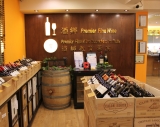With a rich history dating back to 1847, a profound and unique German influence, the Barossa Valley is one of the most famous wine regions of South Australia and, indeed, Australia. The region is now rightly asserting not only its importance to the wine industry but the inestimable value of its storehouse of century-old vines and historic wineries.
The twists and turns of the Barossa Valley are at times as clearly defined as those of the world famous Napa Valley in California. At other times they disappear into a series of rolling hills and transverse valleys, which can easily disorient as well as charm the first time visitor. In consequence, site, slope and aspect all vary widely.
The climate of the region has often been unfairly characterised as very warm but, in fact, in its lower parts it is only moderately so and at higher altitudes quite cool. In fact, its biologically effective temperature summation and ripening mean temperatures are almost identical with those of Margaret River. However, the region does have a wide diurnal temperature range, higher maxima, more sunshine and a much lower humidity and rainfall. All of this adds up to a continental climate ideal for full bodied red wines, excellent fortified wines and generally robust white wines.
There are two basic soil types; brown, loamy sand to clay loam and more sandy light brownish grey to dark grey brown soils. Both are relatively low in fertility -- particularly the second type -- and acidity tends to increase with depth. Traditional viticulture (bush pruning, no irrigation) results in low yields of high quality grapes.
Info: Australian Wine & Brandy Corporation www.wineaustralia.com












